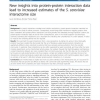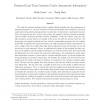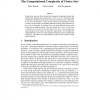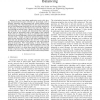253 search results - page 3 / 51 » When More Alternatives Lead to Less Choice |
BMCBI
2010
13 years 4 months ago
2010
Background: As protein interactions mediate most cellular mechanisms, protein-protein interaction networks are essential in the study of cellular processes. Consequently, several ...
IOR
2008
13 years 7 months ago
2008
We study the important problem of how a supplier should optimally share the consequences of demand uncertainty (i.e., the cost of inventory excesses and shortages) with a retailer...
ALMOB
2006
13 years 7 months ago
2006
Background: An important challenge in eukaryotic gene prediction is accurate identification of alternatively spliced exons. Functional transcripts can go undetected in gene expres...
TARK
2007
Springer
14 years 1 months ago
2007
Springer
Social choice rules are often evaluated and compared by inquiring whether they fulfill certain desirable criteria such as the Condorcet criterion, which states that an alternativ...
INFOCOM
2007
IEEE
14 years 1 months ago
2007
IEEE
Abstract—In many networking applications such as file sharing, structured peer-to-peer networks are increasingly used in dynamic situations with fluctuating load, which require...




